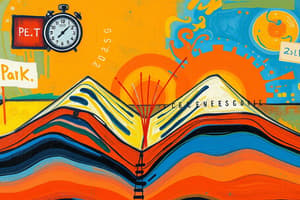Podcast
Questions and Answers
ما هي أحد أسباب حدوث الزلازل؟
ما هي أحد أسباب حدوث الزلازل؟
- التسرب الغازي في الخزانات الجوفية (correct)
- انتقال الأرصاد الجوية
- التفاعلات الكيميائية في الطبقات الأرضية
- التصدع الأرضي
ما هي إحدى الآثار المباشرة للزلازل؟
ما هي إحدى الآثار المباشرة للزلازل؟
- الاهتزاز الأرضي (correct)
- تسرب الغازات السامة
- الاحتراق الناتج عن التفاعلات الكيميائية
- الغمر بالمياه
ما هي إحدى الآثار طويلة المدى للزلازل؟
ما هي إحدى الآثار طويلة المدى للزلازل؟
- تراكم الرواسب والحطام
- تشكيل الجبال والهضاب
- تغيرات في سطح الأرض كالانهيارات والانخفاضات (correct)
- نمو الكائنات الحية البحرية
ما هو المقياس الأكثر شيوعًا لقياس قوة الزلازل؟
ما هو المقياس الأكثر شيوعًا لقياس قوة الزلازل؟
أي من العوامل التالية لا يساهم في حدوث الزلازل؟
أي من العوامل التالية لا يساهم في حدوث الزلازل؟
ما هي مقياس شدة الزلزال الذي يُعتبر موقعيًا ويوفر معلومات تفصيلية عن الظروف المحلية خلال الزلزال؟
ما هي مقياس شدة الزلزال الذي يُعتبر موقعيًا ويوفر معلومات تفصيلية عن الظروف المحلية خلال الزلزال؟
ما الذي تقوم بقياسه مقاييس الزلزال؟
ما الذي تقوم بقياسه مقاييس الزلزال؟
ما هو التأثير الرئيسي للزلازل على المباني والبشر؟
ما هو التأثير الرئيسي للزلازل على المباني والبشر؟
ما هي فائدة دراسة الزلازل بالنسبة لعلماء الأرض؟
ما هي فائدة دراسة الزلازل بالنسبة لعلماء الأرض؟
ما هو التحدي الذي واجه مقاييس شدة زلازل مثل مقياس ريختر؟
ما هو التحدي الذي واجه مقاييس شدة زلازل مثل مقياس ريختر؟
Flashcards are hidden until you start studying
Study Notes
Earthquakes are a natural phenomenon that can have significant consequences on both human settlements and the environment. They result from the movement of tectonic plates beneath the Earth's surface, causing sudden shifts and vibrations. Let's explore the causes, effects, and measurement scales associated with earthquakes.
Causes of Earthquakes
Earthquakes primarily occur due to the shifting of tectonic plates in the Earth's crust. These plates move either horizontally, known as strike-slip earthquakes, or vertically, referred to as thrust earthquakes. Additionally, earthquakes can occur when there is a buildup of pressure within underground reservoirs of fluid, like magma or gas, leading to a sudden release of energy.
Effects of Earthquakes
The immediate effects of earthquakes include the shaking of the ground, which can cause damage to buildings and infrastructure. In some cases, earthquakes may trigger secondary effects like tsunamis, landslides, or volcanic eruptions. These events can lead to further destruction and loss of life. Longer-term consequences may include changes in the Earth's surface, such as fault ruptures or subsidence.
Earthquake Measurement Scales
Earthquakes are measured using various scales designed to quantify their size, energy release, and intensity.
Magnitude Scales
The most commonly used magnitude scale is the Moment Magnitude Scale (MMS), which measures the movement of rock along the fault. It accurately captures larger earthquakes that last longer, cover greater areas, and cause more damage. Other scales, such as the Richter scale, have been replaced due to their limitations in measuring smaller earthquakes and not accounting for factors like depth and location.
Intensity Scales
Intensity scales describe the severity of an earthquake's effects on the environment, humans, and buildings at different locations. One such scale is the Modified Mercalli Intensity Scale, which ranges from I (not felt) to XII (total destruction). Unlike magnitude scales, intensity scales are site-specific and provide more detailed information about local conditions during an earthquake.
Conclusion
Understanding the causes, effects, and measurement scales of earthquakes is crucial for predicting future events, mitigating their impact, and developing strategies for risk reduction. By studying earthquakes, scientists can gain valuable insights into our planet's geology and dynamics, ultimately contributing to safer communities and a better understanding of natural hazards.
Studying That Suits You
Use AI to generate personalized quizzes and flashcards to suit your learning preferences.




